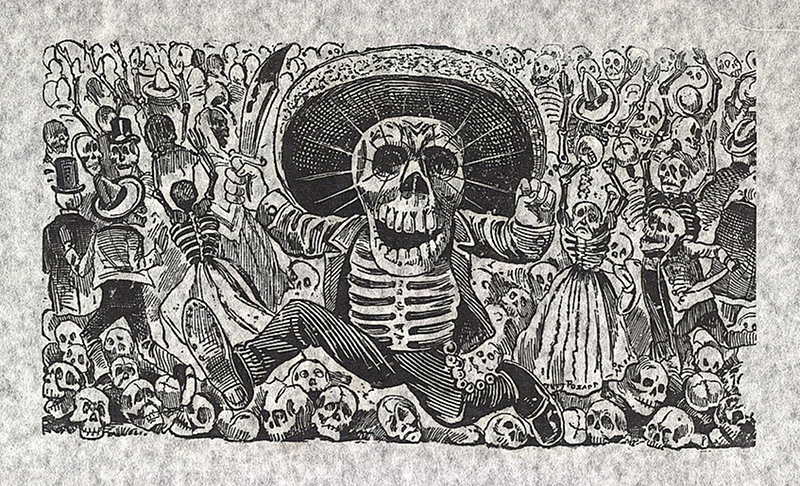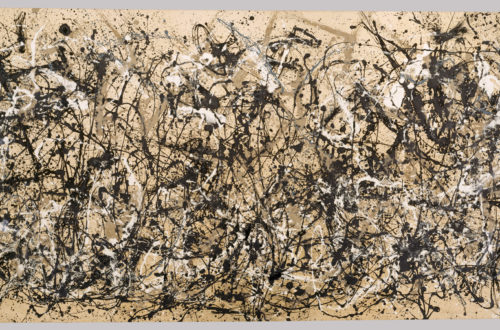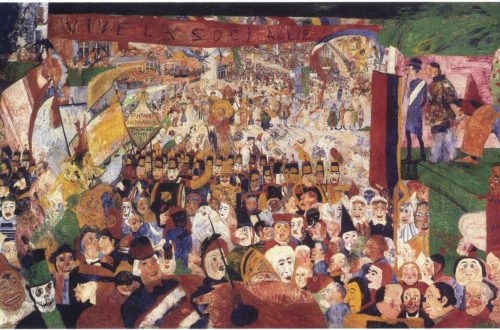Many famous Mexican painters have emerged through the years, adding their unique styles to the country’s cultural heritage. Many people know of world-renowned Mexican artists such as Frida Kahlo and Diego Rivera, yet there are many other famous Mexican painters worth noting. Every painter from Mexico on this list has risen to popularity due to their considerable contributions to the country’s art legacy. Let’s discover more about these famous Mexican artists below!
Famous Mexican Painters Worth Exploring
Mexico is renowned for its ancient ruins, pristine beaches, delicious food, and its rich culture of art and music. This cultural heritage can be traced back to a time before the Spanish colonized the area when Mexico was still part of what was called Mesoamerica. The art from this period mostly centered on the surrounding nature and its various gods. After the Spanish took over the region, the art became more centered on Christian topics, serving as a way for the Spanish to instill their colonial interests into the local populace.
This began to change after 1821 after the country gained its independence from external rule. At this point, Mexican artists began to develop and experiment with their art styles, creating works that were far removed from any European influences. Due to the country’s tumultuous history, many famous Mexican painters have focused on portraying works that highlight the struggles of the Mexican people or that celebrate their culture with pride. However, some Mexican artists have focused on more personal topics or even delved into more surreal portrayals. Let’s discuss some of these famous Mexican painters in our list below.
José Guadalupe Posada (1852 – 1913)
| Artist Full Name | José Guadalupe Posada Aguilar |
| Date of Birth | 2 February 1852 |
| Date of Death | 20 January 1913 |
| Place of Birth | Aguascalientes, Mexico |
| Important Artworks | A Rooster (1885)A Vendor Selling Toys (1885)Don Chepito (1899) |
Posada worked as a farm laborer and in a ceramic factory as a youngster. He then learned engraving and lithography as a teenager. His works are some of the most recognizable, and his influence is possibly the most significant of all Mexican painters, although his name has yet to attain the sort of renown that other Mexican artists on this list have. Posada’s calavera (skeleton) artworks were possibly the most popular objects he produced during his lifetime, and he is often recognized for popularizing the calavera images seen today.
These paintings provide a message to all of us, warning us that death is a fact we all have in common, affluent or poor. Despite his enormous output, Posada garnered little renown throughout his career and died with little recognition. His death is now thought to be the result of years of alcohol consumption, probably linked to Posada’s notorious habit of drinking an excessive amount of tequila. His work’s satirical insight influenced a generation of Latin American painters and cartoonists.
José Clemente Orozco (1883 – 1949)
| Artist Full Name | José Clemente Orozco |
| Date of Birth | 23 November 1883 |
| Date of Death | 7 September 1949 |
| Place of Birth | Ciudad Guzmán, Mexico |
| Important Artworks | Prometheus (1930)Catharsis (1934)Man of Fire (1939) |
Orozco, considered one of the three great Mexican muralists, distinguished himself from the other two (Rivera and Siqueiros) by openly criticizing both the Mexican Revolution and the post-Revolutionary administration. Orozco was regarded as the most complex of the Mexican muralists, capable of conveying darker subject matter than his contemporaries. The work he created was regularly political in nature, and he promoted the political concerns of the working class and peasants.
He was unsatisfied with his early painting style, which was based on European traditions, and subsequently employed forms and imagery from pre-colonial art in Mexico. His works of art are located all around Mexico, including the National Museum in Mexico City, and depict both the beauty and hardships endured by the country’s people over time. In the last years of his life, Orozco was hailed as a national hero for his role in elevating Mexican art to international prominence. Mexico’s president presented him with the Federal Quinquennial Prize in 1947, recognizing him as the most distinguished Mexican individual in the arts and sciences of that time.
Diego Rivera (1886 – 1957)
| Artist Full Name | Diego María de la Concepción Juan Nepomuceno Estanislao de la Rivera y Barrientos Acosta y Rodríguez |
| Date of Birth | 8 December 1886 |
| Date of Death | 24 November 1957 |
| Place of Birth | Guanajuato, Mexico |
| Important Artworks | Zapata-style landscape (1915)The Flower Carrier (1935)Pan American Unity (1940) |
Diego Rivera was a very famous muralist and painter from Mexico who was born in Guanajuato. His parents encouraged the young Rivera to pursue his love of art since he was only three years old. He spent around a decade living in Europe, where he rose to prominence among avant-garde painters in Paris. His paintings typically represented the life of indigenous and working-class Mexicans and thus regarded as a pioneer of the Mexican Muralist movement. Diego Rivera’s artworks typically addressed contentious issues such as economic injustice, communism, oppression, and their impact on society.
Rivera was a passionate communist who received a lot of condemnation for his politically driven artworks. Rivera also collaborated with other painters to produce large-scale murals that graced whole walls, along with painting portraits that portrayed social issues experienced by everyday Mexican people. Rivera’s contributions to the revival of Latin American murals were significant, and he remains a source of inspiration for artists all around the world today. He left behind a substantial body of work that will eternally bear witness to his talent as a painter and his ardent desire for constructive political dialogue through artistic expression.
David Alfaro Siqueiros (1896 – 1974)
| Artist Full Name | David Alfaro Siqueiros |
| Date of Birth | 29 December 1896 |
| Date of Death | 6 January 1974 |
| Place of Birth | Camargo, Mexico |
| Important Artworks | América Tropical (1932)Birth of Fascism (1936)Echo of a Scream (1937) |
Siqueiros viewed politics and art as inextricably linked. His large and colorful paintings were filled with issues that reinforced his communist ideals. He was so committed to his political ideas that he declined any commission that contradicted it. He was also not hesitant to use art in his political activity. The artist’s work and life appeared to oscillate between approval and rejection. During the 1920s and early 1930s, he was regularly imprisoned for his political activities, however, he was commissioned to create what is maybe his most renowned painting The Myths, at the National Preparatory School in 1922.
Siqueiros visited the United States in the 1930s, and his murals there recounted the tale of the States’ forceful connection with Latin America. His work led him to South America and back to New York, where he established a school for aspiring painters. Jackson Pollock, who had just started out at the time, was among the pupils. Siqueiros was convicted and sentenced to five years in prison in 1959 by the Mexican government for promoting the activities of a railway workers’ union. After his release in 1964, he continued to demonstrate his fervent support for left-wing challenges.
Rufino Tamayo (1899 – 1991)
| Artist Full Name | Rufino Tamayo |
| Date of Birth | 25 August 1899 |
| Date of Death | 24 June 1991 |
| Place of Birth | Oaxaca, Mexico |
| Important Artworks | Woman in Gray (1931)Three People (1970) Watermelons (1977) |
Tamayo, along with the other three major muralists of the time, brought global recognition to the art scene in Mexico in the latter part of the previous century. Unlike his peers, however, Tamayo did not add an obvious political message in his artwork, nor did he utilize figurative realism to transmit and celebrate what was known as “Mexicanidad”- pride in Mexico’s distinctive ethnic and cultural mixture. For the artist, “Mexicanidad” was not precisely established; he wasn’t in agreement with the three great Mexican muralists’ excessive nationalism and patriotism.
He struggled with portraying Mexican identity, attempting to express the authentic essence of Mexico as opposed to the anecdotal Mexico. He focused more on experimenting with shapes, materials, and colors, and his style was more schematic, broken, and abstract than traditional figurative realism permitted. The artist imagined art and life as a global heartbeat, combining inspirations from Mexican and foreign sources such as Surrealism and Cubism. Tamayo’s art was first shown in the States in 1926 at the Weyhe Gallery in New York. A decade later, he relocated to New York, where he engaged in the vibrant postwar art culture scene in the city.
María Izquierdo (1902 – 1955)
| Artist Full Name | María Izquierdo |
| Date of Birth | 30 October 1902 |
| Date of Death | 2 December 1955 |
| Place of Birth | San Juan de los Lagos, Mexico |
| Important Artworks | The Racket (1938)Self Portrait (1940)Living Still Life (1947) |
Maria Izquierdo is well-known and revered because she was the first female painter from Mexico whose artwork was displayed in America. Izquierdo dedicated every moment of her life to creating work that reflected her Mexican heritage, and she held her own against prominent Mexican male painters such as the three great Mexican muralists. She quickly distinguished herself as an artist who created works featuring circus scenes, altars, still lifes, and female portraits. Izquierdo deviated from what many of her classmates at Mexico’s Academy of Fine Arts were doing by associating her works of art with popular Mexican traditions.
Instead of political themes, she created visual moments with personal significance and foundations in the cultural traditions of Mexico. Many people regard Mara Izquierdo as among the most prominent female painters from Mexico and think of her as something of a feminist icon. However, despite the fact that she was a female Mexican artist who worked during the same period as renowned feminist Latin American artists, she did not identify as a feminist personally. Despite major hurdles during her career, Izquierdo broke down boundaries and defied gender preconceptions.
Frida Kahlo (1907 – 1954)
| Artist Full Name | Magdalena Carmen Frida Kahlo y Calderón |
| Date of Birth | 6 July 1907 |
| Date of Death | 13 July 1954 |
| Place of Birth | Coyoacán, Mexico City, Mexico |
| Important Artworks | Frieda and Diego Rivera (1931)Henry Ford Hospital (1932)The Two Fridas (1939) |
Following a serious car accident, Kahlo found herself stuck in her bed in hospital for endless hours. It was here that she decided to start painting to pass the time. Frida Kahlo was among the first Mexican women to represent themselves in portraiture and her deeply personal portraits have made her more than just a renowned female painter from Mexico, but also an artist who is widely acclaimed across the globe and regarded as one of the most influential characters in the history of art. She painted herself because she was her most available subject.
Kahlo’s artworks deal with subjects such as gender roles, identity, and the fragility of the human body. Her paintings often incorporate vibrant colors while merging aspects of Mexican folk art practices, contributing substantially to the advancement of Mexican art in her lifetime. While Kahlo was not particularly recognized outside of her native country during her lifetime, her global appeal has risen since then as a greater number of individuals have learned to recognize and appreciate the raw honesty rooted inside every work she produced. She was also married to the aforementioned painter from Mexico. Diego Rivera, however, their relationship was a tumultuous one.
Remedios Varo (1908 – 1963)
| Artist Full Name | María de los Remedios Alicia Rodriga Varo y Uranga |
| Date of Birth | 16 December 1908 |
| Date of Death | 8 October 1963 |
| Place of Birth | Anglès, Spain |
| Important Artworks | Eyes on the Table (1938)Gypsy and Harlequin (1947)Harmony (1956) |
Varos was born in 1908 in northeast Spain. Her father was a hydraulic engineer, and his job often necessitated the family to relocate. He had his daughter duplicate his technical engineering designs after recognizing her artistic aptitude early on in life. Her father, an intellectual, exposed her to the works of Alexandre Dumas, Edgar Allan Poe, and Hieronymus Bosch, as well as documents on science, mysticism, and philosophy. Varo, like many Surrealists, was fascinated by Sigmund Freud’s and Carl Jung’s psychoanalytic concepts, both of which focused on the complexities of the unconscious and hidden impulses.
Varos’ early exposure to Cubist and Surrealist painters, particularly the work of Georges Braque, influenced her subsequent work. Varo, Kahlo, and Carrington are often regarded as the most important female painters involved with the Surrealist movement in Mexico. Varo was virtually unknown outside of Mexico after her passing, but her fame has progressively risen in recent years, coinciding with a surge in interest for female Surrealists across the globe. Her mysterious paintings of androgynous figures engaging in magic arts or the occult are her most well-known works.
Leonora Carrington (1917 – 2011)
| Artist Full Name | Mary Leonora Carrington |
| Date of Birth | 6 April 1917 |
| Date of Death | 25 May 2011 |
| Place of Birth | Clayton Green, Clayton-le-Woods, United Kingdom |
| Important Artworks | Portrait of Max Ernst (1939)Green Tea (1942)Bird Bath (1974) |
Carrington portrayed transient images of the mind in which true memories and imaginary visions coexist. In her colorful cosmos, etheric beings conduct rituals for unexplained reasons; these entities have female and animal features and seem to be midway between people and creatures. She outlived the majority of her Surrealist contemporaries, and when she passed in 2011, she left a huge oeuvre of work behind. Her connection with artist Max Ernst overshadowed their significance for some time. She was long recognized by those in the art world for being prickly and unyielding, refusing to engage in self-promotion or share details about her art pieces.
She hated discussing her art, and when pressed in an interview about where she got her inspiration, she stated she was as enigmatic to herself as she was to others. She also published a few works as an author and many of her narratives are subtle retorts to the male surrealists’ views on women. She departed Mexico in 1968 after attending several political protest gatherings and being warned by the authorities that she was in danger. She spent the following 25 years in the United States, reclaiming her independence, and eventually returned to Mexico in 2006.
Gabriel Orozco (1962 – Present)
| Artist Full Name | Gabriel Orozco |
| Date of Birth | 27 April 1962 |
| Date of Death | Present |
| Place of Birth | Xalapa, Mexico |
| Important Artworks | Autumn Umbrella (1993)Kiss of the Egg (1997)Pink Pond Table (1998) |
Orozco’s work, which spans painting, photography, video, and sculpture, examines philosophical quandaries through spatial connections and chance encounters. He makes the poetry of whimsy, absurdity, and random connections apparent by using common materials in the present urban environment. More recently, in his works of art, Orozco has studied the phenomenology of structures, whereby the circle functions as a bridge between organic matter and geometry, and color sequencing is based on chess movement principles. The artist was born into an artistic household, his father being an art professor and mural painter.
Orozco worked on multiple paintings alongside his father in his teens to save enough for his own car. Following his self-education as an artist, Orozco chose a nomadic lifestyle, which influenced his paintings. Orozco’s artwork compels viewers to pay attention to hidden and ignored details in both natural and urban settings. He was born in Veracruz in 1962 and grew up in Mexico City in a cultural environment associated with photography, muralism, and leftist politics. Orozco’s status as a well-known Mexican artist arose in the early 1990s when he presented pieces that combined social critique and humor.
In this article, we explored the significant impact that each of these famous Mexican painters had on the art world, not just in their own country, but also worldwide. As we have learned, many Mexican artists focused on expressing their political views in their artworks. However, others, such as Frida Kahlo, focused on a far more personal experience of their life in Mexico. Some sought to incorporate traditional Mexican patterns and ideas, while others tried to redefine what it means to be Mexican.
Frequently Asked Questions
What Do Famous Mexican Painters Paint About?
Every Mexican artist produces art with their own unique outlook and perspective. However, because of Mexico’s rocky history, a big topic in Mexican art involves the country’s politics. However, not all artists share the same political views. Another common theme in Mexican art is the celebration of traditional Mexican culture. Yet, many Mexican works also display the incorporation of European influences.
Who Is the Most Famous Painter from Mexico?
There are so many notable and famous Mexican painters who have left their mark on the world of art. However, many would regard Frida Kahlo to be among the most famous of these artists. Not only was she widely regarded in her own country, but also highly respected all across the globe. Other famous Mexican painters include her husband, Diego Rivera, as well as Remedios Varo, Leonora Carrington, Gabriel Orozco, Rufino Tamayo, and José Clemente Orozco.













